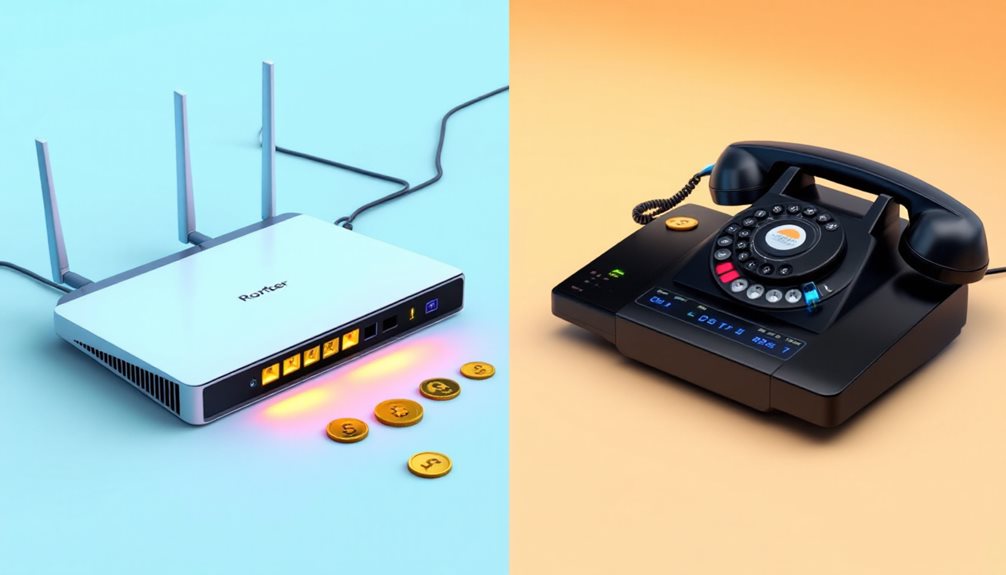VOIP technology evolved from an expensive, unreliable communication method in the 1990s to today’s cost-effective standard. Early implementations suffered from poor call quality, frequent disconnections, and costly network upgrades that negated promised savings. However, reliable broadband emergence, standardized protocols like SIP, and fierce market competition drove costs down 60-80%. Modern VOIP delivers 99.99% uptime with minimal infrastructure requirements, while integrated features like video conferencing provide measurable productivity gains that further enhance return on investment for organizations seeking extensive communication solutions.
Expert Highlights
- Early VOIP in the 1990s failed to deliver promised cost savings due to expensive network upgrades and technical limitations.
- Affordable broadband internet and standardized SIP protocols reduced enterprise voice solution deployment costs by sixty percent in the 2000s.
- Fierce market competition between telecom giants and VOIP startups drove monthly service costs down by 60-80 percent.
- Modern SIP trunking allows businesses to save up to 60% on phone costs with 99.99% uptime guarantees.
- Cloud-hosted VOIP eliminates costly on-site maintenance while requiring minimal hardware compared to traditional PBX systems.
Early VOIP Challenges and Limited Cost Savings in the 1990s

When Voice over Internet Protocol (VOIP) technology first emerged in the 1990s, organizations discovered that the promised cost savings often fell short of expectations due to significant technical limitations and infrastructure requirements. Companies faced poor call quality, frequent disconnections, and expensive network upgrades that offset potential savings from reduced traditional phone bills. Modern SIP Trunking solutions now provide guaranteed 99.99% uptime with redundant carrier connections, eliminating many of these early reliability concerns.
Infrastructure Improvements That Reduced Implementation Expenses
As broadband internet became more reliable and affordable in the early 2000s, businesses found that VOIP implementations no longer required the costly network overhauls that had plagued earlier adopters. Companies could leverage existing Ethernet infrastructure, while standardized protocols like SIP eliminated proprietary hardware dependencies. These developments reduced initial deployment costs by sixty percent, making enterprise-grade voice solutions accessible to organizations previously priced out. Modern VoIP systems require only minimal internet requirements of 100kbps per concurrent call, further reducing infrastructure demands for businesses of all sizes.
Competitive Market Forces Driving Down Service Pricing

How did service providers respond to the growing accessibility of VOIP infrastructure? Fierce competition emerged as numerous companies entered the market, creating downward pressure on pricing that benefited consumers worldwide. This competitive landscape forced providers to innovate while reducing costs, making professional-grade communication accessible to businesses of all sizes.
Fierce market competition drove VOIP prices down while forcing innovation, making enterprise-level communication tools accessible to businesses of every size.
- Price wars between established telecom giants and emerging VOIP startups – driving monthly service costs down by 60-80% compared to traditional phone systems
- Bundled service offerings combining voice, video, and data – creating extensive communication packages at competitive rates
- Subscription-based pricing models replacing expensive hardware investments – eliminating upfront capital expenditures for small businesses
The implementation of SIP trunking has allowed businesses to save up to 60% on their phone costs while maintaining high-quality digital communication.
Feature Integration and Value-Added Services Impact on ROI
Why do businesses often struggle to justify VOIP investments when focusing solely on basic calling features? Smart organizations recognize that integrated features like video conferencing, instant messaging, and CRM connectivity transform VOIP from a simple phone replacement into a broad communication platform. These value-added services deliver measurable productivity gains, reduced training costs, and enhanced collaboration that greatly improve return on investment. Cloud PBX solutions offer businesses 99.999% uptime guarantee through geo-redundant infrastructure, ensuring communication reliability that traditional systems cannot match.
Current Cost Comparison Between VOIP and Traditional Phone Systems

Three major cost categories separate VOIP systems from traditional phone infrastructure, creating dramatic differences in both upfront expenses and ongoing operational budgets. Organizations examining telecommunications investments discover considerable disparities that directly impact their bottom line performance.
- Installation costs – VOIP requires minimal hardware versus expensive traditional PBX systems
- Monthly service fees – Internet-based calling reduces per-line charges considerably
- Maintenance expenses – Cloud-hosted solutions eliminate costly on-site technical support requirements
Frequently Asked Questions
What Are the Typical Monthly Bandwidth Costs for Enterprise VOIP Deployments?
Enterprise VOIP bandwidth costs typically range from $20-100 monthly per user, depending on call volume and quality requirements. Organizations find these predictable expenses help budget planning while providing scalable communication solutions that grow alongside their business needs.
How Do International Calling Rates Compare Between VOIP Providers and Carriers?
VoIP providers typically offer international calling rates 60-80% lower than traditional carriers. Businesses choosing VoIP join cost-conscious organizations achieving significant savings, with rates often under $0.05 per minute versus carrier rates exceeding $0.20 per minute internationally.
What Hidden Fees Should Businesses Expect When Switching to VOIP Systems?
Businesses typically encounter setup fees, equipment costs, monthly service charges, and potential bandwidth upgrade expenses. Many providers also charge for advanced features like call recording, conferencing capabilities, and premium technical support services.
Do VOIP Cost Savings Justify the Employee Training and Transition Expenses?
Smart businesses recognize that VoIP cost savings typically offset training expenses within months. Organizations joining the digital transformation find that streamlined communication processes and reduced phone bills validate initial investment in employee education and system shift.
Which VOIP Security Investments Are Essential and How Much Do They Cost?
Essential VOIP security investments include encrypted protocols, firewalls, and intrusion detection systems, typically costing $50-200 per user monthly. Organizations prioritizing communication protection recognize these measures as fundamental safeguards against cyber threats and data breaches.
Expert Final Thoughts
VOIP technology has transformed from a costly, unreliable communication experiment in the 1990s to today’s dominant business solution, delivering up to 60% cost savings compared to traditional phone systems. Infrastructure improvements, competitive pricing pressures, and integrated feature sets have eliminated early implementation barriers while maximizing return on investment. Organizations now benefit from superior functionality, scalability, and dramatic expense reduction, making VOIP adoption a strategic necessity rather than optional upgrade.






